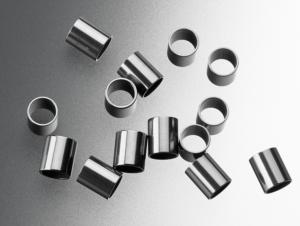Mechanizing the Deburring of Small Parts for High Volumes
Without a doubt, the key to deburring small metal parts is to not form a burr in the first place — which, not coincidentally, is one of the underpinnings of Metal Cutting’s business. Our proprietary method allows us to cut thick-walled and thin-walled tubes, as well as hard, soft, and specialty metals, without forming a burr at all.
However, we know there are many metal fabrication processes for which our cutting method is not suitable — such as a cross hole in a machined tubular part or other circumstances where a burr will, indeed, form after metal fabrication is performed.
While, conceptually, the most obvious solution is cutting metal burr by hand, that process is simply not practical for high-volume production. However, it is useful to take a look at hand deburring, because the same basic principle is what is needed when we mechanize the process for cutting metal burr for high volumes of small metal parts.
What are the basics of cutting metal burr by hand?
First of all, what is deburring metal? In short, it is the removal of any raised edge or other small, unwanted bit of metal that remains attached to a workpiece after it has been machined or otherwise fabricated.
The classic hand deburring process removes these burrs using one of two common types of tool designs:
- The curved blade style acts as a curved tearing knife.
- The countersink style trades maneuverability for the ability to act on a full circle.
It is these basic tool shapes and the actions they perform that remove the burr, typically from an edge of a metal part.
For example, variations of the curved blade allow you to use different wrist actions to achieve a chamfer or simply remove a protruding burr. You can also adjust the corner angle depending on whether the burr is inward or external.
For right angle surfaces or burrs in two different directions, this type of tool is effective because it is optimal for straight edges or holes.
While the countersink design obviously cannot act on straight edges and does not have the freedom of motion to work at different angles, it can quickly and uniformly deburr around a hole in one motion.
Why use a mechanical method for cutting metal burr?
For Metal Cutting’s high-volume operations, our goal is to produce a burr-free surface without using electrochemistry or hand tools. Why?
While electrochemistry permeates hidden corners and hard-to-reach areas of small parts, its removal rates are relatively uniform except for known corner ratios. Simply put, that means electrochemistry does not distinguish between burr and not a burr — removing all material equally.
So, electrochemistry acts on both the burr and the rest of the material at a steady rate.
That is not a big issue if the burr is attached by a very small thread. However, if a burr is very thick or smeared, the process of cutting the metal burr may also risk removing too much of the part’s material.
And again, as we said earlier, deburring small parts by hand is simply impractical — not to mention costly and time consuming — for mass production.
But before we turn to a mechanized solution, we need to think about what action it is providing. If the action is similar to what a hand tool provides, then the mechanical method is a good candidate for use in metal deburring.
What are the basic mechanical metal deburring methods?
The main kinds of mass finishing machines used for deburring small parts are the barrel tumbler and the vibratory tumbler.
A barrel tumbler, which removes large exposed burrs but is not ideal for parts with recesses, rotates a load so that parts slide down the barrel like rocks down a hill. In the barrel deburring process, the parts are abraded and deburred as they bump and scrape against the media and each other.
A vibratory tumbler creates a scrubbing action of surrounding media against parts and is generally used for very smooth surfaces. Compared with a barrel tumbler, a vibratory tumbler is very effective for recessed areas and twice the speed.
How does barrel deburring work?
A barrel tumbler excels at deburring parts with heavy radiuses or where more material can be removed and corners can be rounded off. The cutting action of a barrel tumbler occurs on about 20% to 30% of the load.
While the speed and amplitude of vibration to be used will vary on different machines, in general:
- High speeds and small amplitudes are used for fine finishes or delicate parts.
- Large amplitudes are used for heavier cutting.
With barrel tumbling, high speeds and large amplitudes can roll burrs in or peen metal into holes and mushroom edges.
How does vibratory deburring work?
A vibratory tumbler produces an action similar to filing — applying an upward, angular force that causes a shearing action where parts and media rub together. The larger the parts or media are, the faster the cutting action will be.
A vibratory tumbler grinds at an applied force that is five to ten times the force exerted by the free-falling action of a barrel tumbler. Unlike a barrel tumbler, a vibratory tumbler cuts the entire load with each pulse, resulting in a shorter cycle time.
A vibratory tumbler can be used on fragile parts with small radiuses because there is no tearing action or unequal forces to cause bends or distortion.
What other factors affect a deburring tumbler?
Both types of deburring tumblers use preformed media such as stone, ceramic, or plastic. Water is added to both carry away dirt and carry the media.
As needed, chemicals may be used to enhance the action or clean the parts. An abrasive is often added to enhance the cutting and deburring ability of the tumbling media.
Interestingly, the abrasive itself mostly does not act on the parts; rather, it helps to keep the tumbling media rough enough to do the job.
What is Metal Cutting’s deburring method for small parts?
Our metal cutting specialists use the action of mechanical devices such as our centrifugal barrel finishing and tumbling systems to re-create, as best we can, what hand deburring tools do.
The challenge is getting access and having an inertial action — that is, getting into very small, confined spaces and exerting sufficient action to deburr a part.
And that is a challenge we meet by utilizing our unique, proprietary inertial action, which enables us to reach and remove burrs in even the most difficult-to-reach areas of parts.
You can also learn more about specifying small metal parts cutting and finishing — including deburring — by downloading a free copy of our guide How to Fine-Tune Your Quote Request to Your Maximum Advantage: Frequently Asked Questions in Small Parts Sourcing.






